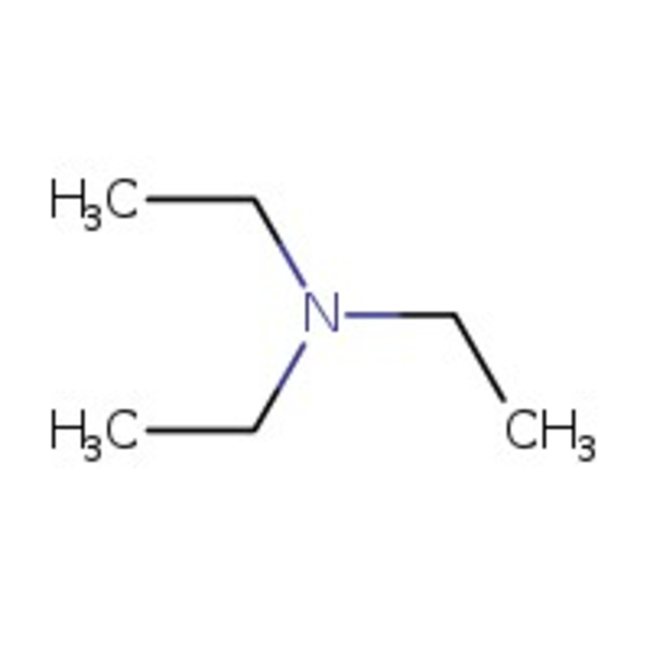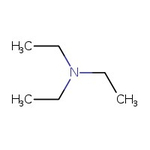Search Thermo Fisher Scientific
Thermo Scientific Chemicals
Triethylamine, 99%
CAS: 121-44-8 | C6H15N | 101.193 g/mol
| Catalog Number | Quantity |
|---|---|
| ALFA12646.AP | 500 mL |
Catalog number ALFA12646.AP
View Price:Sign InSign in to see your account pricing. Need an account? Register with us today.
Quantity:
500 mL
Specifications
Chemical Name or MaterialTriethylamine
CAS121-44-8
Health Hazard 1H225-H302-H311+H331-H314-H335-H336
Health Hazard 2GHS H Statement
H225-H314-H302-H312-H332
H225-H314-H302-H312-H332
Health Hazard 3P210-P233-P235-P240-P241-P242-P243-P260-P264b-P270-P271-P280-P303+P361+P353-P304+P340-P305+P351+P338-P310-P330-P331-P363-P370+P378q-P501c
View more
Triethylamine is a base used to prepare esters and amides from acyl chlorides as well as in the synthesis of quaternary ammonium compounds. It acts as a catalyst in the formation of urethane foams and epoxy resins, dehydrohalogeantion reactions, acid neutralizer for condensation reactions and Swern oxidations. It finds application in reverse phase high-performance liquid chromatography (HPLC) as a mobile-phase modifier. It is also used as an accelerator activator for rubber, as a propellant, as a corrosion inhibitor, as a curing and hardening agent for polymers and for the desalination of seawater. Furthermore, it is used in automotive casting industry and textile industry.
This Thermo Scientific Chemicals brand product was originally part of the Alfa Aesar product portfolio. Some documentation and label information may refer to the legacy brand. The original Alfa Aesar product / item code or SKU reference has not changed as a part of the brand transition to Thermo Scientific Chemicals.
Applications
Triethylamine is a base used to prepare esters and amides from acyl chlorides as well as in the synthesis of quaternary ammonium compounds. It acts as a catalyst in the formation of urethane foams and epoxy resins, dehydrohalogeantion reactions, acid neutralizer for condensation reactions and Swern oxidations. It finds application in reverse phase high-performance liquid chromatography (HPLC) as a mobile-phase modifier. It is also used as an accelerator activator for rubber, as a propellant, as a corrosion inhibitor, as a curing and hardening agent for polymers and for the desalination of seawater. Furthermore, it is used in automotive casting industry and textile industry.
Solubility
Miscible with water, ether and ethanol.
Notes
Incompatible with strong oxidizing agents.
Triethylamine is a base used to prepare esters and amides from acyl chlorides as well as in the synthesis of quaternary ammonium compounds. It acts as a catalyst in the formation of urethane foams and epoxy resins, dehydrohalogeantion reactions, acid neutralizer for condensation reactions and Swern oxidations. It finds application in reverse phase high-performance liquid chromatography (HPLC) as a mobile-phase modifier. It is also used as an accelerator activator for rubber, as a propellant, as a corrosion inhibitor, as a curing and hardening agent for polymers and for the desalination of seawater. Furthermore, it is used in automotive casting industry and textile industry.
Solubility
Miscible with water, ether and ethanol.
Notes
Incompatible with strong oxidizing agents.
RUO – Research Use Only
General References:
- The apparent base strength of triethylamine has been increased by its use in combination with certain metal salts, examined by Rathke. For the acylation of malonic esters with acyl chlorides, MgCl2 was found to be effective, whereas other metal salts had no effect: J. Org. Chem., 50, 2622 (1985); Synth. Commun., 15, 1039 (1985); Tetrahedron, 48, 9233 (1993). For the Horner-Wadsworth-Emmons olefination reaction, LiBr or LiCl gave the best results under most conditions, although Mg salts showed some effect; other metal salts were ineffective: J. Org. Chem., 50, 2624 (1985).
- Addition of triethylamine enables the reaction of Grignard reagents with esters to be interrupted at the ketone stage. Deuterium-labelling shows that this is caused by enolization of the ketone. Good yields are obtained unless the ester itself is readily enolized: Synthesis, 877 (1980).
- Murahashi, S. I.; Zhang, D.; Iida, H.; Miyawaki, T.; Uenaka, M.; Murano, K.; Meguro, K. Flavin-catalyzed aerobic oxidation of sulfides and thiols with formic acid/triethylamine. Chem. Commun. 2014, 50 (71), 10295-10298.
- Soni, R.; Hall, T. H.; Mitchell, B. P.; Owen, M. R.; Wills, M. Asymmetric reduction of electron-rich ketones with tethered ru(II)/TsDPEN catalysts using formic acid/triethylamine or aqueous sodium formate. J. Org. Chem. 2015, 80 (13), 6784-6793.



